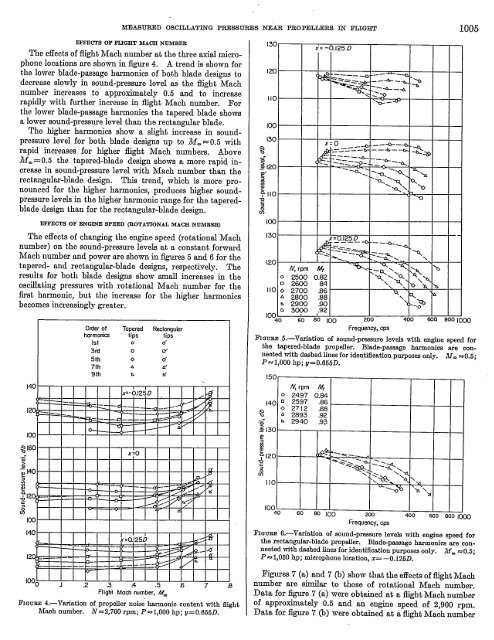REPORT 1377 - CAFE Foundation
REPORT 1377 - CAFE Foundation
REPORT 1377 - CAFE Foundation
Create successful ePaper yourself
Turn your PDF publications into a flip-book with our unique Google optimized e-Paper software.
M3WS’URJID OSCILLATING PRESSUEEIS NEAR PILOPEIJZRS IN FLIGHT 1005EPFECTS OF FLIGHT MACH NUMBERThe effects of flight Mach number at the three axial microphonelocations are shown in iignre 4. A trend is shown forthe lower blade-passage harmonics of both blade designs todecrease slowly in sound-pressure level as the flight Machnumber increases to approximately 0.5 and to increaserapidly with further increase in ilight Mach number. Forthe lower blade-passage harmonics the tapered blade showswlower sound-pressure level than the rectangular blade.The higher harmonics show a slight increase in soundpressurelevel for both blade designs up to Ill.= 0.5 withrapid increases for higher fight Mach numbers. AboveMw=0.5 the tapered-blade design shows a more rapid increasein sound-pressure level with Mach number than therectangular-blade design. This trend, which is more pronouncedfor the higher harmonics, produces higher soundpressurelevelsin the higher harmonic range for the taperedbladedesign than for the rectangular-blade design.EFFECT%OF ENGINE SPEED (ROTAmONAL MACH NUMBER)The effects of changing the engine speed (rotational Machnumber) on the sound-pressure levels at a constant forwardMach number and power are shown in figures 5 and 6 for thetapered- and rectanguhwblade designs, respectively. Theresults for both blade designs show small increases in theoscillating pressures with rotational Mach number for thetit harmonic, but the increase for the higher harmonicsbecomes increasingly greater.03[30120110la)130120 —x.- b.125 DIIc —— __ --- &------ _ __4_-w--I I I I I I I(110 0 2700 .86 —QA 2800 .88\ ‘4 %C. 2900 .90 \ +DW30 .921004o&80 [~ 200 400 EOo 800 ]~Frequency, CPS~GURH 5.—Variation of sound-p~ure Ievek with engine speed forthe tapered-blade propeller. Blad&passage harmonioa are conneotedwith dashed lines for identiiioation purposes only. l.f~ =0.5;P s1,000 hp;~=().f355~.150e rpm M,o 2497 0.84140 n 2597 .860 2712 .883 A 2893 .92~ 2940 .93“$-130%_.y-s!;[ n&140‘eHi-——, I! =Q125L7b — +.--L l.=-- —- – F “ -+ % ‘%HIIoq I I I I I I I I I I I I I I I IJ 23 .4 .5 6 7 BFlight Mach number, MmFIGURE A.—Variation of propeller noim’ harmonio content with tighthfaoh number. i’f =2,700 rpm; P= 1,000 hp; &= O.6651).i& .;120 ( .+ P>_.+. “*..2\\\ %G,:, :=*\\;110 “ ..-=3% ‘2 ‘ ~‘-w ‘h \h10040 Go80 ]@ 200 400 600 aoa .. IrFrequawy, cpsFIGURE 6.—Variation of sound-praw.ure levels with engine speed forthe rectanguhm-bide propeller. Blade+pwage harmonim are conneotedwith daahed linM for identification purposes only. ilf= =0.5;P =1,060 hp; microphone Ioeation, x= –0.1261).Figures 7 (a) and 7 (b) show that the effects of flight Machnumber are similar to those of rotational Mach number.Data for @we 7 (a) were obtained at a flight Mach numberof approximately 0.5 and an engine speed of 2,900 rpm.Data for @ure 7 (b) were obtained at a flight Mach numberxl
















